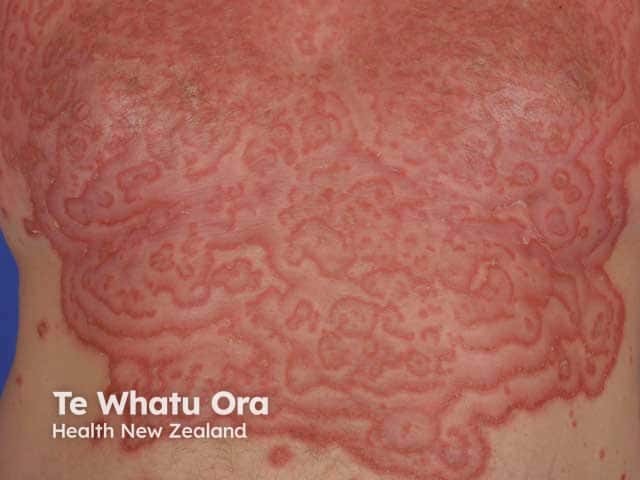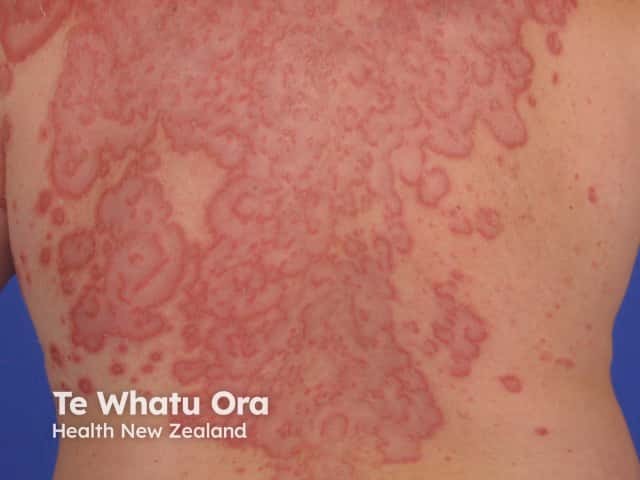Main menu
Common skin conditions

NEWS
Join DermNet PRO
Read more
Quick links
Erythema gyratum repens — extra information
Erythema gyratum repens
Author: Dr Cathy Yunjia Zhao, Dermatology Registrar, Westmead Hospital, Sydney, NSW, Australia. DermNet Editor in Chief: Adjunct A/Prof Amanda Oakley, Dermatologist, Hamilton, New Zealand. Copy edited by Gus Mitchell/Maria McGivern. January 2019.
Introduction Demographics Causes Clinical features Diagnosis Differential diagnoses Treatment
What is erythema gyratum repens?
Erythema gyratum repens is a rare paraneoplastic type of annular erythema with a distinctive figurate ‘wood-grain’ appearance. It has a strong association with malignancy.

Erythema gyratum repens-like appearance in pemphigus foliaceus

Erythema gyratum repens-like appearance in pemphigus foliaceus

Erythema gyratum repens-like appearance in pemphigus foliaceus
*This patient's rash had a wood-grain appearance like erythema gyratum repens but the rash was actually pemphigus foliaceus.
Who gets erythema gyratum repens?
Erythema gyratum repens is most often present in Caucasian men in their 60s. The male to female ratio is 2:1. There is an associated underlying malignancy in 80% of patients with erythema gyratum repens. Almost half of the patients with erythema gyratum repens have lung cancer (33–47%), and less commonly, oesophageal, breast, and stomach cancer [1,2].
In rare cases, erythema gyratum repens has also been described in association with mycobacterial infections, connective tissue diseases, and pregnancy [1].
What causes erythema gyratum repens?
The strong association between erythema gyratum repens and malignancy has led to several different pathogenetic hypotheses. These hypotheses are described below.
- The main hypothesis is that erythema gyratum repens is the result of a cross-reaction between two different antibodies that each react against tumour antigens and cutaneous antigens. The responsible cutaneous antigen is not known. This is supported by the fact that direct immunofluorescence of skin in erythema gyratum repens has shown granular deposits of immunoglobulin G and complement C3 in the dermoepidermal junction (the tissue where the epidermal and dermal layers connect), with similar deposits also being seen in the associated neoplasm [3].
- An alternate hypothesis is that a tumour may have produced substances capable of changing the constituents of the skin, leading to the deposition of antibodies and complement activation [3].
- Recently, a link was proposed between cutaneous glutamine (a substance required for the proliferation of cells) and the multi-ring appearance of erythema gyratum repens [2].
What are the clinical features of erythema gyratum repens?
Erythema gyratum repens presents with concentric erythematous rings that have a distinctive wood-grain appearance. The rings progress in waves, with the leading edge migrating about 1 cm/day. A trailing or collarette scale may be seen. Erythema gyratum repens is very itchy.
The annular plaques most often involve the limbs and trunk [1].
How is erythema gyratum repens diagnosed?
Although erythema gyratum repens may be diagnosed clinically, a skin biopsy is often performed to exclude other conditions. The histological features of erythema gyratum repens are non-specific.
Other investigations to be undertaken may include a complete blood count, biochemistry, antinuclear antibody profile, and malignancy screens (ie, chest X-ray, mammogram, cervical smear, tumour markers, computed tomography of the chest/abdomen/pelvis and, if indicated, endoscopy or colonoscopy) [1].
What is the differential diagnosis for erythema gyratum repens?
Other conditions that should be considered in the course of diagnosis include:
- Erythema annulare centrifugum
- Subacute cutaneous lupus erythematosus
- Lupus erythematosus gyratum repens (a variant of bullous cutaneous lupus)
- Necrolytic migratory erythema
- Other inflammatory skin diseases
- Erythema chronicum migrans (the first stage of Lyme disease)
- Tinea imbricata (tinea corporis due to fungal infection with Trichophyton concentricum).
What is the treatment for erythema gyratum repens?
The treatment for erythema gyratum repens is to identify and treat the primary malignancy. Erythema gyratum repens usually resolves once the malignancy has been removed, for example, with surgical resection. Topical steroids have not been found to be effective [1].
References
- Rustin M, Cerio R. Chapter 47. Reactive inflammatory erythemas. In: Griffiths C, Barker J, Bleiker T, Chalmers R, Creamer D (eds). Rook’s textbook of dermatology. 9th edn. Oxford: Wiley-Blackwell, 2016: 47.1–47.17.
- Dewitt C, Buescher LS, Stone SP. Chapter 153. Cutaneous manifestations of internal malignant disease: Cutaneous paraneoplastic syndromes. In: Goldsmith LA, Katz SI, Gilchrest BA, Paller AS, Leffell DJ, Wolff K (eds). Fitzpatrick’s dermatology in general medicine. 8th edn. New York: McGraw-Hill, 2012.
- Holt PA & Davies MG. Erythema gyratum repens: an immunologically mediated dermatosis? Br J Dermatol 1977; 96: 343–7. PubMed
- Forrester DM. Self-assembled multi-ring formations of glutamine and a possible link to erythema gyratum repens. Med Hypotheses 2015; 85: 10–16. PMID: 25804239. PubMed
On DermNet
- Erythema gyratum repens pathology
- Erythema annulare centrifugum
- Annular erythema
- Cutaneous lupus erythematosus
